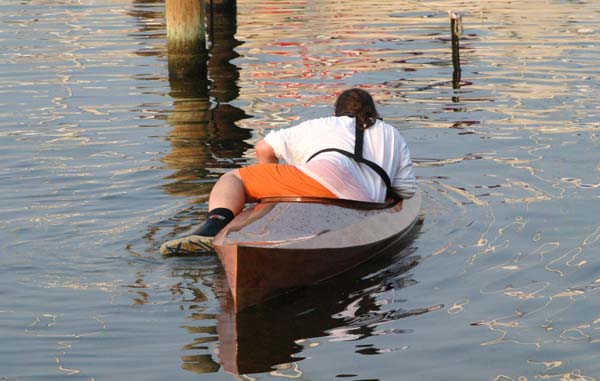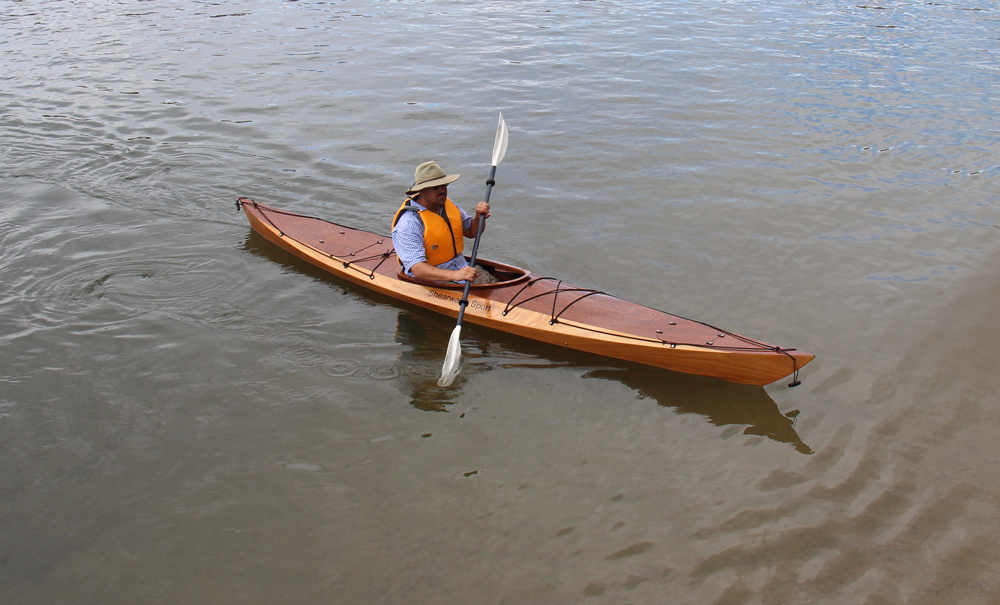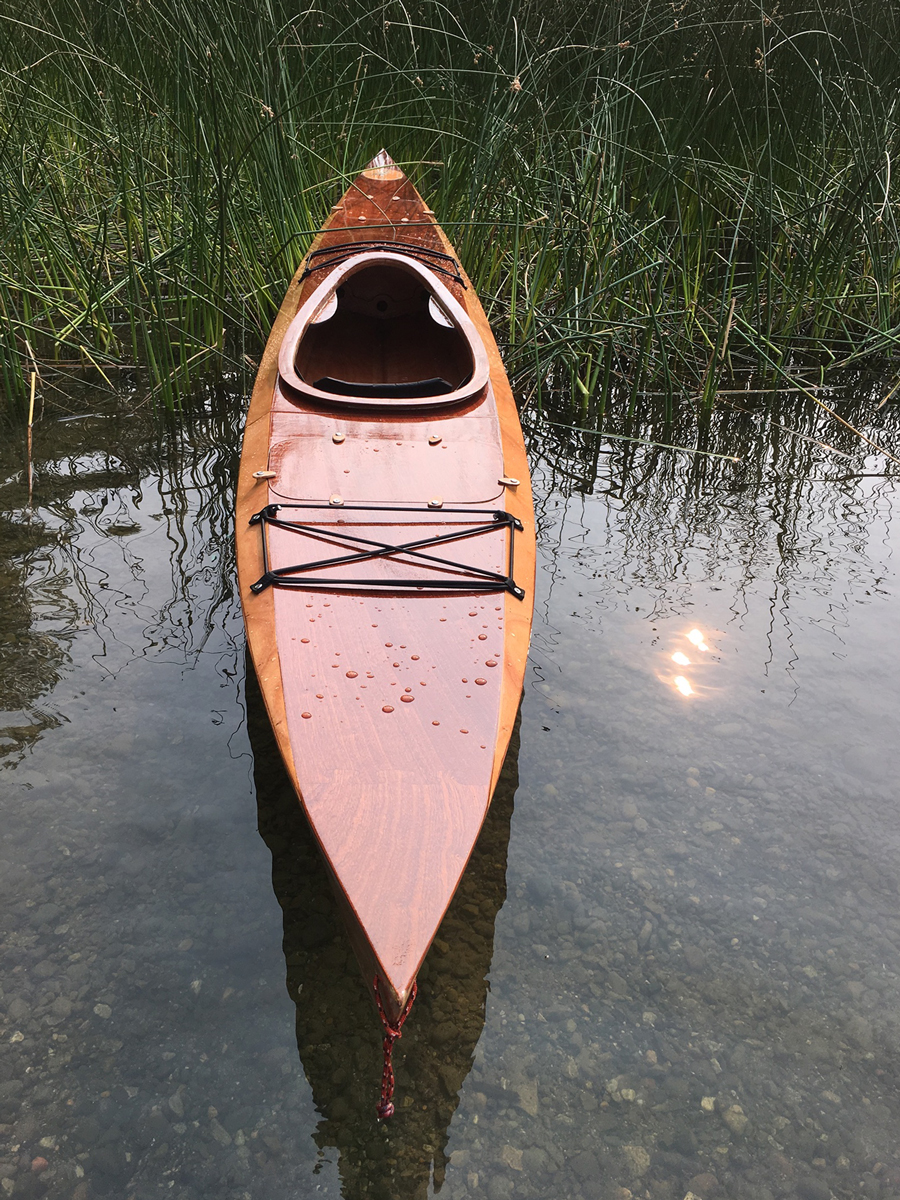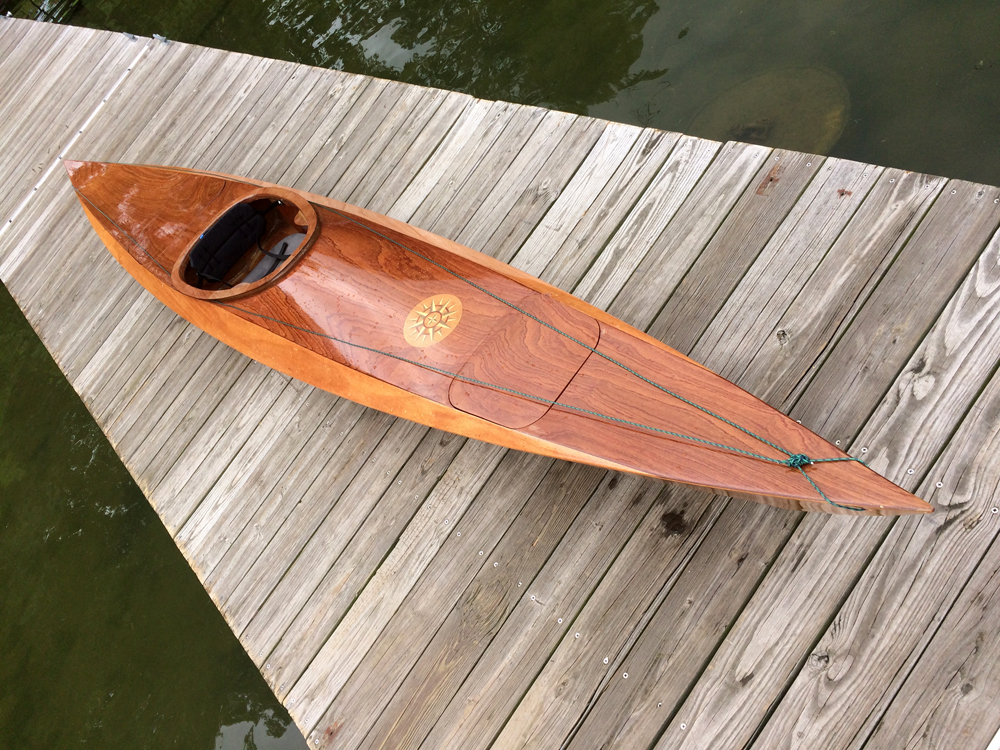Builders' Forum |
|
| ↓ Scroll to Last Comment ↓ | Forum Guidelines | Builders' Forum | |
Thinking ahead to using my kayak, and wanting to make sure that I can get back in the boat if I come out.
1) I plan to put a perimeter line on the front section -- does anyone have pictures of what that looks like on a sectional?
2) I'm thinking that it would not be a lot of fun to pull myself up on top of the toggle closures for the hatch - has anyone done that? It seems like either the "invisible closures" or straps with buckles would be less painful. Any thoughts? How do people install the straps if they go that route?
16 replies:
RE: preparing for self rescue
Thanks, very helpful.
In the first picture, I can't quite see what the attachment at the bow looks like, and how it interacts with the carry handle. Can you share another picture?
In the second one, it looks like the lines are going inside the boat -- what's the attachment there? How does it avoid having water come in through those holes?
I appreciate the advice to tape out the pattern to see how the lines will run before drilling holes...
And agree that I wouldn't want to do a lot of rescue practice in the wooden boat -- but I also don't want to be paddling a boat that I can't get into if something goes wrong and I find myself swimming.
RE: preparing for self rescue
Hi ELB,
here is another picture of another boat i built a bit back that may show that line detail better:
 if you look at the blue boat (and you can open this picture in its own tab and enlarge it), you see the yellow perimeter line. then you also see a purple loop of line around the perimeter line right behind the toggle. you slide that purple line back to tension up the perimeter line...it also keeps it on the deck.
if you look at the blue boat (and you can open this picture in its own tab and enlarge it), you see the yellow perimeter line. then you also see a purple loop of line around the perimeter line right behind the toggle. you slide that purple line back to tension up the perimeter line...it also keeps it on the deck.
in the second picture, it is just a different rigging system called a maroske fitting. it is described at this link: https://www.clcboats.com/modules/catalog/product.php?category_qn=boat-building-supplies-epoxy-fiberglass-plywood&subcat_qn=sailboat-rigging-hardware&code=maroske-kayak-deck-fittings
its a bit expensive, but they are very slick and good looking and its a u shaped tube behind the deck that the line gets threaded into. becuase its a tube, no water gets in the boat. so its another way to do rigging instead of loops of strap.
totally agree that you want to practice. i just practice a little carefully with my wood boats. i ussually learn a skill first with the plastic boat to get the basics understood....then translate it to my wood boat. after i have worked it out in the plastic boat, i usually have a good understanding of where the pressure points are going to be so i am a lot less rough when i get to my 'nice boats'.
h
RE: preparing for self rescue

Here's the rigging on my long skinny blue boat. Nylon strap eyes screwed into the sheer clamps and secured with brazz finish washers hold the line. A brass padeye at the front and back holds the line and offers a place to tie a handle to. When I paddle there's also a paddle float tucked into the aft rigging. With a skinny boat like this I'm not sure if a wet re-entry would be possible without it. Even if it was, it'd be a lot more difficult. The paddle leash and GPS mini dry bag clip to the forward rigging and the bailing pump tucks into the rigging on the right side. Note how I've finessed the question of hatch cover restraints by simply skipping the hatches. My camelbak and the pocket on my spray skirt hold enough stuff fo an entire day of paddling. If I need something else it can go into a dry bag tucked into the forward rigging.

Now on a wide boat like the WD12, you don't need a paddle float or perimeter lines. This was at demo night at Pier 7, 14 1/2 years ago, when I first tried out the then brand-new WD12. At that time it hadn't had any rigging installed at all. I was able to exit without any water getting into the boat at all. Re-entry was just as easy. I gripped the coaming to get started, then pushed up (from the right side of the boat). It leaned until the coaming was almost in the water, but not quite. Once I got far enough across the cockpit it settled back down. I turned toward the back of the boat, pulled my legs in, rolled over, sat up and was ready to go.
I'm not sure exactly how the sectional hull shape falls in the range between the WD12 and WR18, but I think that a paddle float and perimeter lines are probably a good idea.
Have fun,
Laszlo
RE: preparing for self rescue
I'm taking your advice to use tape to look at how lines will fall before doing any drilling. Because the hatches on the Shearwater Sport Sectional run all the way to the sides of the deck, it looks like the perimeter line will go over the edge of the hatch cover unless I keep it on the sheers. It seems like this might make it a pain to get the hatches on and off -- and with the sectional, I do need to be able to open them to assemble and disassemble the boat, even if I'm not carrying much gear. I just looked through the galleries of photos, and don't see anything like what I was hoping to do. Any advice?
RE: preparing for self rescue
fwiw, i don't think a line going over a hatch will make it challenging or difficult to remove. i agree, i don't see that a lot in most of the rigging plans i have seen, but i assume that is becuase perimeter lines are generally more effective when they are close to the perimeter....and most hatches don't go all the way out to the perimeter.
that said, if you look at the perimeter lines on the shearwater 17 in the picture above (close to the top of this thread), you will see the perimeter lines come right up against the hatch lines....and that seems to look fine and was no trouble interfering with the hatches. is that what you are seeing in your proposal?
it would be great if you were to share a picture of your idea. but i would say if it looks good, go for it.
h
RE: preparing for self rescue
I've been following this thread with some interest. I'm still a long way away from anything hands-on with deck rigging on my Sectional Shearwater Sport, but it's something that's been on my mind. I'm also aspiring to have perimeter lines and some way to secure a paddle with a float for self-rescue, but I've not seen many images of Shearwaters that provision rigging for these things. As Laszlo noted, I also wonder if the increased stability of this boat largely negates these needs.
I found this image of a regular Shearwater Sport that seems to do a good job with perimeter lines. Note the extra strapping around the hatches to keep the lines clear.

The Sectional introduces some special considerations here though:
- It's 3 pieces, so having the perimeter lines span sections and tie into to the strapping for the elastic lines isn't really possible, at least not in the front.
- The rear hatch is immediately behind the cockpit, not some distance behind as with the other Shearwaters. This makes aft rigging a bit of a head scratcher.
I suppose the first difference could be addressed by just adding a couple extra straps just forward of the front bulkhead. Then the perimeter lines become a permanent part of the front section.
The second difference makes me wonder if aft elastic rigging is best avoided. Where would it go and still be useful? That said, here's an example where the elastic lines were moved back a bit to fit the sectional design. Maybe this would also work fine to secure a paddle with a float for self rescue, and could maybe even help guide permitter lines as well.

Another interesting option would be removable perimeter lines. The image below is not a sectional, but it seems like this kind of rigging could be made removable to accommodate a sectional (e.g. take it off when disassembling the sectional). I suppose some sort of cleat would be needed somewhere though. Has anyone tried anything like this?

RE: preparing for self rescue
FYI The post above was from me. It looks like my login session expired. It's weird that it still let me post anonymously.
RE: preparing for self rescue
Self Rescue.............you may be thinner, younger and more limber than I.
Cowboy rescues and the days I swam up kicked and rolled over the gunwhale of a canoe are over. I'm needing help and/or my paddle float. The buckles over my hatches don't get in the way cause I'm primarily coming over the side of the cockpit. The skirt, the pfd, the big belly, and the stiffness from Arthur(-ittus) are worse than the deck rigging.
RE: preparing for self rescue
Grumpy, amen! Any self-rescue strategy that requires one to be in peak physical and mental condition can be questionable. Most of the times I've needed to self-rescue, I've been tired, cold, and was in trouble because my concentration was already compromised.
Planning for and practicing self-rescue is important, but never assume that you'll be in good enough condition to execute. The bottom line is to make sure you have the personal floatation necessary to keep from drowining even when incapacitated and the means to signal for help when necessary.
Cheers,
Dick
RE: preparing for self rescue
"1) I plan to put a perimeter line on the front section ...."
If you are going to put them in the front, do the back also. Sometimes that's all you get to hang onto. It is also a place to lash deck cargo..... for me I often use it to stash the kayak cart when long ramps, trails are included in launch and recovery.
Here is a link to assisted "heel-hook" rescue. Note use of front and back lines.
https://www.youtube.com/watch?v=j-zpJQeiaNc&t=44s
RE: preparing for self rescue
Or a paddle float rescue.. hooks the rear lines.
https://youtu.be/hkj2S4yxoQI
that and a cowboy rescue mounts the boat over the rear deck. Rear lines.......
RE: preparing for self rescue
This is helpful -- yes, the perimeter lines need to be solely on the front and back sections. I don't think something removeable would be reliably strong enough to hold with my full weight pulling on it. I hadn't been planning on elastic webbing in the back, although I agree a loop around the perimeter lines behind the hatch could be useful for holding a paddle float. I think the key takeaway from the pictures is that I should plan on running the perimeter line through the hole at the ends, along with a grab loop.
Based on discussion elsewhere in the forum, I'm trying to drill-fill-drill all the needed holes now, while I'm finishing up the sanding, but won't actually add the hardware until after I varnish.
RE: preparing for self rescue
Just remember
that though they might look neat and "shipshape", you don't want your perimeter lines too tight- you have to be able to get a grip with your hand (and glove). The above links to rescue techniques are great for all of us to review.
RE: preparing for self rescue
I'm enjoying all the info here. ELB, it'll be really interesting to see what you come up as a solution for the sectional if you are able to share later.
RE: preparing for self rescue
Have the hatch toggles on my shearwater and never have even noticed them when scrambling up the deck. I suggest you learn paddle float rentry and reentry and roll with paddle float and extended paddle ( this is the most reliable in rough conditions) t rescue is also a must













RE: preparing for self rescue
» Submitted by - Wed, 12/8/21 » 8:14 PM
hi ELB,
f i were to be putting a perimeter line in the front section, i would set up 2 nylon web straps slightly forward of hatch. i would run a bungee between the two straps (to complement the bungees in front of the cockpit/allow for holding a paddle on the deck) and a perimeter line from the straps forward to through the hole drilled into the bow for the toggle line and back with a rope loop on the deck to allow you to tension it.
an example is below....the difference is you would not extend the perimeter line back from the forward section....you can do the same thing on the back.
you could adapt this further by puting hooks in the line or otherwise tie it after assembly if you wanted a complete perimeter line. another example that could be adapted is below:
you can use blue tape to model your lines before you make any final decision. i find this a good practice...a picture of what i mean is below:
on your question about toggles, i can't honestly speak from experience doing a lot of rescue practice on my boats. when i do practice rescues, i am usually using a plastic (polyethelene) boat i have. but based on how that boat is set up and how my other boats are set up, i would not worry about the toggles. the toggles are relatively low profile compared to other arrangements like straps. the other thing i would note is that the toggle system is very secure and that has a lot of value. strapped hatches are very challenging to keep from leaking becuase it is very difficult to get enough down pressure without building some structure that itself will cause you to get hung up on a re-entry. you can get hung up on straps (i have) and if the strap is also holding your hatch down, that can be a really bad combination. i am curious what others have to say on the matter.
fwiw...and i am really interested to hear from other kayakers on the questions of rescue practice. i consider my CLC builds, while great kayaks, not the kind of boat that i really like to bang around....and some kinds of rescue practice (re-entries and team rescues) i associate with a lot of banging around...so i usually swap to my plastic dagger for that practice.
on my boats, i practice roles and less dramatic rescues (like exiting) but have not subjected them to a lot of wet re-entry practice (maybe not a good idea...just being honest here). if you do want to get agressive in that kind of practice, i would consider reinforcing the back deck with some extra internal and external glass. don't get me wrong, these boats are plenty strong, but like any high end composite kayak, they don't take well to certain point loads that can sometimes happen during practice rescues if they are not reinforced to handle that....and i think i would strengthen the layup in certain areas (aft deck mainly) if i was going to get aggressive in using the boat that way.
the other thing, and again, i am really interested in other perspectives here, is that a sectional would, in my view, be relatively weak compared to the equivelent non-sectional against certain types of loads that could be experienced with aggressive rescues....so that factors a bit in my thinking. again, nothing that could not be addresses with some extra attention/ glass .....but is something i would think about.
i think you are asking great questions and am interested to hear other and maybe even CLC perspective on your question and or my thoughts.
h